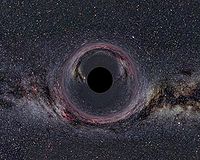- Compact star
-
In astronomy, the term compact star (sometimes compact object) is used to refer collectively to white dwarfs, neutron stars, other exotic dense stars, and black holes. These objects are all small for their mass. The term compact star is often used when the exact nature of the star is not known, but evidence suggests that it is very massive and has a small radius, thus implying one of the above-mentioned possibilities. A compact star which is not a black hole may be called a degenerate star.
Contents
Compact stars as the endpoint of stellar evolution
Compact stars form the endpoint of stellar evolution. A star shines and thus loses energy. The loss from the radiating surface is compensated by the production of energy from nuclear fusion in the interior of the star. When a star has exhausted all its energy and undergoes stellar death, the gas pressure of the hot interior can no longer support the weight of the star and the star collapses to a denser state: a compact star.
Lifetime
Although compact stars may radiate, and thus cool off and lose energy, they do not depend on high temperatures to maintain their pressure. Barring external perturbation or baryon decay, they will persist virtually forever, although black holes are generally believed to finally evaporate from Hawking radiation. Eventually, given enough time (when we enter the so-called degenerate era of the universe),[1] all stars will have evolved into dark, compact stars.
A somewhat wider class of compact objects is sometimes defined to contain, as well as compact stars, smaller solid objects such as planets, asteroids, and comets. These compact objects are the only objects in the universe that could exist at low temperatures. There is a remarkable variety of stars and other clumps of matter, but all dense matter in the universe must eventually end in one of only five classes of compact objects.
Planets
At low density (planets and the like) the object is held up by electromagnetic forces. These forces constrain electrons to occupy orbitals around nuclei, which give rise to chemical bonds and thus allow stiff objects such as rocks to exist. These objects are so stiff that they do not compress very much when mass is added. Adding more (cold) mass therefore makes the object larger: radius increases with mass.
Eventually a point is reached where the central pressure is so great that all matter is ionized so that the electrons are stripped from the nuclei and move freely. No chemical bonds now exist to hold up the object. This point is reached at the center of the planet Jupiter. Add more mass to Jupiter and the increase of pressure is smaller than the increase of gravity, so the radius will decrease with increasing mass. The object will shrink.
A planet such as Jupiter has about the largest volume possible for a cold mass.[2] Add mass to Jupiter and the planet's volume, somewhat counter-intuitively, becomes smaller. The central density now is large enough that the free electrons become degenerate. This term means that the electrons have fallen into the lowest-energy states available. Since electrons are fermions, they obey the Pauli exclusion principle, and no two electrons can occupy the same state. The electrons thus occupy a wide band of low-energy states. Compressing the mass forces this band to widen, creating the quantum-mechanical force of electron degeneracy pressure which now holds the center of the planet apart. (The ions present contribute almost no force.)
White dwarfs
 The Eskimo Nebula is illuminated by the white dwarf at its center.
The Eskimo Nebula is illuminated by the white dwarf at its center. Main article: White dwarf
Main article: White dwarfThe stars called degenerate dwarfs or, more usually, white dwarfs are made up mainly of degenerate matter—typically, carbon and oxygen nuclei in a sea of degenerate electrons. White dwarfs arise from the cores of main-sequence stars and are therefore very hot when they are formed. As they cool they will redden and dim until they eventually become dark black dwarfs. White dwarfs were observed in the 19th century, but the extremely high densities and pressures they contain were not explained until the 1920s.
The equation of state for degenerate matter is "soft", meaning that adding more mass will result in a smaller object. Continuing to add mass to what is now a white dwarf, the object shrinks and the central density becomes even larger, with higher degenerate-electron energies. The star's radius has now shrunk to only a few thousand kilometers, and the mass is approaching the theoretical upper limit of the mass of a white dwarf, the Chandrasekhar limit, about 1.4 times the mass of the Sun.
If we were to take matter from the center of our white dwarf and slowly start to compress it, we would first see electrons forced to combine with nuclei, changing their protons to neutrons by inverse beta decay. The equilibrium would shift towards heavier, more neutron-rich nuclei which are not stable at everyday densities. As the density increases, these nuclei become still larger and less well-bound. At a critical density of about 4·1014 kg/m³, called the neutron drip line, the atomic nucleus would tend to fall apart into protons and neutrons. Eventually we would reach a point where the matter is on the order of the density (~2·1017 kg/m³) of an atomic nucleus. At this point the matter is chiefly free neutrons, with a small amount of protons and electrons.
Neutron stars
Main article: Neutron starIn certain binary stars containing a white dwarf, mass is transferred from the companion star onto the white dwarf, eventually pushing it over the Chandrasekhar limit. Electrons react with protons to form neutrons and thus no longer supply the necessary pressure to resist gravity, causing the star to collapse. If the center of the star is composed mostly of carbon and oxygen then such a gravitational collapse will ignite runaway fusion of the carbon and oxygen, resulting in a Type Ia supernova which entirely blows apart the star before the collapse can become irreversible. If the center is composed mostly of magnesium or heavier elements, the collapse continues.[3][4][5] As the density further increases, the remaining electrons react with the protons to form more neutrons. The collapse continues until (at higher density) the neutrons become degenerate. A new equilibrium is possible after the star shrinks by three orders of magnitude, to a radius between 10 and 20 km. This is a neutron star.
Although the first neutron star was not observed until 1967 when the first radio pulsar was discovered, neutron stars were proposed by Baade and Zwicky in 1933, only one year after the neutron was discovered in 1932. They realized that because neutron stars are so dense, the collapse of an ordinary star to a neutron star would liberate a large amount of gravitational potential energy, providing a possible explanation for supernovae.[6][7][8] This is the explanation for supernovae of types Ib, Ic, and II. Such supernovae occur when the iron core of a massive star exceeds the Chandrasekhar limit and collapses to a neutron star.
Like electrons, neutrons are fermions. They therefore provide neutron degeneracy pressure to support a neutron star against collapse. In addition, repulsive neutron-neutron interactions[citation needed] provide additional pressure. Like the Chandrasekhar limit for white dwarfs, there is a limiting mass for neutron stars: the Tolman-Oppenheimer-Volkoff limit, where these forces are no longer sufficient to hold up the star. As the forces in dense hadronic matter are not well understood, this limit is not known exactly but is thought to be between 2 and 3 times the mass of the Sun. If more mass accretes onto a neutron star, eventually this mass limit will be reached. What happens next is not completely clear.
Exotic stars
Main article: Exotic starAn exotic star is a compact star composed of something other than electrons, protons, and neutrons balanced against gravitational collapse by degeneracy pressure or other quantum properties. These include strange stars (composed of strange matter) and the more speculative preon stars (composed of preons).
Exotic stars are largely theoretical, but observations released by the Chandra X-Ray Observatory on April 10, 2002 detected two candidate strange stars, designated RX J1856.5-3754 and 3C58, which had previously been thought to be neutron stars. Based on the known laws of physics, the former appeared much smaller and the latter much colder than they should, suggesting that they are composed of material denser than neutronium. However, these observations are met with skepticism by researchers who say the results were not conclusive.
Quark stars and strange stars
Main article: Quark starIt is possible that the neutrons will decompose into their component quarks. In this case, the star will shrink further and become denser, but it may survive in this new state indefinitely if no extra mass is added. It has become a very large nucleon. A star in this hypothetical state is called a quark star or strange star. The pulsars RX J1856.5-3754 and 3C58 have been suggested as possible quark stars.
Preon stars
A preon star is a proposed type of compact star made of preons, a group of hypothetical subatomic particles. Preon stars would be expected to have huge densities, exceeding 1023 kilogram per cubic meter - intermediate between quark stars and black holes. Preon stars could originate from supernova explosions or the big bang; however, current observations from particle accelerators speak against the existence of preons.
Q stars
Q stars are hypothetical compact, heavier neutron stars with an exotic state of matter where particle numbers are preserved. Q stars are also called "gray holes".
Electroweak stars
Main article: Electroweak starAn electroweak star is a theoretical type of exotic star, whereby the gravitational collapse of the star is prevented by radiation pressure resulting from electroweak burning, that is, the energy released by conversion of quarks to leptons through the electroweak force. This process occurs in a volume at the star's core approximately the size of an apple, containing about two Earth masses.[9]
Other ideas
- Boson star
Black holes
Main article: Stellar black holeAs we add more mass, equilibrium against gravitational collapse reaches its breaking point. The star's pressure is insufficient to counterbalance gravity and a catastrophic gravitational collapse occurs in milliseconds. The escape velocity at the surface, already at least 1/3 light speed, quickly reaches the velocity of light. No energy or matter can escape: a black hole has been created. All light will be trapped within an event horizon, and so a black hole appears truly black, except for the possibility of Hawking radiation. It is presumed that the collapse will continue.
In the classical theory of general relativity, a gravitational singularity will be created occupying no more than a point. There may be a new halt of the catastrophic gravitational collapse at a size comparable to the Planck length, but at these lengths there is no known theory of gravity to predict what will happen. Adding any extra mass to the black hole will cause the radius of the event horizon to increase linearly with the mass of the central singularity. This will induce certain changes in the properties of the black hole, such as reducing the tidal stress near the event horizon, and reducing the gravitational field strength at the horizon. However, there will not be any further qualitative changes in the structure associated with any mass increase.
Alternate black hole models
- Fuzzball
- Gravastar
- Dark energy star
- Black star
- Magnetospheric eternally collapsing object
- Dark star
- Primordial black holes
References
- ^ http://www.fathom.com/course/10701055/session3.html
- ^ Guillot, Tristan (1 October 1999). "Interiors of Giant Planets Inside and Outside the Solar System". Science 286 (5437): 72–77. Bibcode 1999Sci...286...72G. doi:10.1126/science.286.5437.72. PMID 10506563. http://www.gps.caltech.edu/~mbrown/classes/ge131/notes/guillot.pdf. Retrieved 2011-10-13.
- ^ http://articles.adsabs.harvard.edu//full/seri/ApJ../0414//L000108.000.html
- ^ http://articles.adsabs.harvard.edu/cgi-bin/nph-iarticle_query?1996ApJ...460..489R&data_type=PDF_HIGH&type=PRINTER&filetype=.pdf
- ^ http://www.journals.uchicago.edu/ApJ/journal/issues/ApJ/v593n2/57716/57716.html
- ^ http://adsabs.harvard.edu/abs/2001AAS...199.1501O
- ^ http://www.pnas.org/cgi/reprint/20/5/254
- ^ http://www.pnas.org/cgi/reprint/20/5/259
- ^ D. Shiga (4 January 2010). "Exotic stars may mimic big bang". New Scientist. http://www.newscientist.com/article/dn18334-exotic-stars-may-mimic-big-bang.html. Retrieved 2010-02-18.
- ^ Small, dark, and heavy: But is it a black hole?, Matt Visser, Carlos Barcelo, Stefano Liberati, Sebastiano Sonego, February 2009
- ^ How Quantum Effects Could Create Black Stars, Not Holes
- D. Blaschke, S. Fredriksson, H. Grigorian, A. M.Oztas, and F. Sandin, The phase diagram of three-flavor quark matter under compact star constraints. (arXiv:hep-ph/0503194)
- Fredrik Sandin, Compact stars in the standard model - and beyond, Eur. Phys. J. C.
- Fredrik Sandin, Exotic Phases of Matter in Compact Stars. (May 8, 2005)
Formation Fate Black dwarf · Type Ia supernova (Candidates) · Neutron star (Pulsar · Magnetar · Related links) · Stellar black hole (Related links) · Compact star (Quark star · Exotic star) · Extreme helium star · Subdwarf B star · Helium planetIn binary systems Nova (Remnant · List) · Dwarf nova · Symbiotic nova · Cataclysmic variable star (AM CVn star · Polar · Intermediate polar) · X-ray binary (Super soft X-ray source) · Binary pulsar (X-ray pulsar · List) · Helium flash · Carbon detonationProperties Related Planetary nebula (List) · RAMBOs · White dwarf luminosity function · Timeline of white dwarfs, neutron stars, and supernovaeNotable Neutron star Types Single pulsars Binary pulsars Properties Neutron-star oscillation · Neutronium · Tolman-Oppenheimer-Volkoff limit · Rp-process · Gamma-ray burst · Optical · Timing noise · Relativistic · Glitch · Pulsar kicks · Bondi accretion · Quasi-periodic oscillations · Urca process · StarquakeRelated Compact star (Quark star · Exotic star) · Supernova (Supernova remnant · Related links) · Hypernova · Quark nova · White dwarf (Related links) · Stellar black hole (Related links) · Radio star · Pulsar planet · Pulsar wind nebula · Thorne-Żytkow objectDiscovery Satellite Investigation of Other Star Evolution Formation · Pre–main sequence · Main sequence · Horizontal branch · Asymptotic giant branch · Dredge-up · Instability strip · Red clump · PG1159 star · Mira variable · Planetary nebula · Protoplanetary nebula · Luminous red nova · Luminous blue variable · Wolf–Rayet star · Supernova impostor · Supernova · Hypernova · Hertzsprung–Russell diagram · Color–color diagram
Protostars Molecular cloud (H II region) · Bok globule · Young stellar object · Herbig–Haro object · Hayashi track · Hayashi limit · Henyey track · Orion (T Tauri · FU Orionis) · Herbig Ae/Be
Luminosity class Subdwarf · Dwarf (Blue · Red) · Subgiant · Giant (Blue · Red) · Bright giant · Supergiant (Blue · Red · Yellow) · Hypergiant (Yellow) · Blue straggler
Spectral classification Remnants White dwarf (Black dwarf · Helium planet) · Neutron star (Pulsar · Magnetar) · Stellar black hole · Compact star (Quark · Exotic) ·
Stellar core: EF Eridani BFailed and
theoretical starsSubstellar object (Brown dwarf · Sub-brown dwarf · Planetar) · Boson star · Dark-matter star · Quasistar · Thorne–Żytkow object · Iron star
Nucleosynthesis Alpha process · Triple-alpha process · Proton–proton chain · Helium flash · CNO cycle · Lithium burning · Carbon burning · Neon burning · Oxygen burning · Silicon burning · S-process · R-process · Fusor · Nova (Remnants)
Structure Core · Convection zone (Microturbulence · Oscillations) · Radiation zone · Photosphere · Starspot · Chromosphere · Corona · Stellar wind (Bubble) · Asteroseismology · Eddington luminosity · Kelvin–Helmholtz mechanism
Properties Designation · Dynamics · Effective temperature · Kinematics · Magnetic field · Magnitude (Absolute) · Mass · Metallicity · Rotation · UBV color · Variability
Star systems Earth-centric
observation ofPole star · Circumpolar star · Magnitude (Apparent · Photographic · Color) · Radial velocity · Proper motion · Parallax · Photometric-standard star
Lists Star names · Arabic names · Chinese names · Most massive · Least massive · Largest · Brightest (Historical) · Most luminous · Nearest (Nearest bright) · Stars with exoplanets · Brown dwarfs · Planetary nebulae · Novae · Notable supernovae · Supernova remnants · Supernova candidates · Timeline of stellar astronomy
Related articles Planet · Star cluster · Association · Open cluster · Globular cluster · Galaxy · Supercluster · Helioseismology · Guest star · Constellation · Asterism · Gravity · Intergalactic star · Infrared dark cloud
Supernovae Classes Related - Near-Earth supernova
- Supernova impostor
- Hypernova
- Quark-nova
- Pulsar kicks
Structure Progenitors Remnants Discovery Lists - Notable supernovae
- Supernova remnants
- Candidates
- Massive stars
- In fiction
Notable Research Categories:- Black holes
- Star types
- Compact stars
- Exotic matter
Wikimedia Foundation. 2010.



